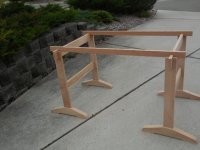I don't have a Domino...yet. I've never hand cut a mortise and I don't think I ever will. I've drilled them and then chiseled but I don't think I'll do that again either. I've cut them with a up-cut spiral bit in a plunge router and I would do that again. I have some chairs I like that I make with a pattern and plunge cut the mortises off the pattern. Normally I use my hollow chisel mortiser. If I had a domino 500, I would probably use the mortiser for bigger mortises. But the Domino looks like it is quicker and makes mortises as nice as the plunge router, nicer than the mortiser. It also takes up less space than my hollow chisel mortiser.
I have a pocket screw jig and used it just today. I also have a biscuit joiner. I will continue to use it but not for some of the things I've used it for in the past. I don't think you need a biscuit joiner if you have a domino. But I think you will still want a pocket hole jig. I don't think you will want to see pocket holes in nicer furniture but on painted furniture you can fill the holes and not look at them. Mainly I use them where they don't show and in shop projects where I don't mind the appearance. Wood magazine tested joints and said pocket screws were stronger than domino joints which weren't as strong as traditional mortise and tenon. Their results were at least in part due to the sizes of the parts they tested but I still don't think you need to look down on pocket screws from a strength standpoint. They are surprising strong - but pretty ugly. Domino joints are, other than more limited size flexibility, the same as traditional mortise and tenon. They are slip tenons but that is fine.
I have a pocket screw jig and used it just today. I also have a biscuit joiner. I will continue to use it but not for some of the things I've used it for in the past. I don't think you need a biscuit joiner if you have a domino. But I think you will still want a pocket hole jig. I don't think you will want to see pocket holes in nicer furniture but on painted furniture you can fill the holes and not look at them. Mainly I use them where they don't show and in shop projects where I don't mind the appearance. Wood magazine tested joints and said pocket screws were stronger than domino joints which weren't as strong as traditional mortise and tenon. Their results were at least in part due to the sizes of the parts they tested but I still don't think you need to look down on pocket screws from a strength standpoint. They are surprising strong - but pretty ugly. Domino joints are, other than more limited size flexibility, the same as traditional mortise and tenon. They are slip tenons but that is fine.


